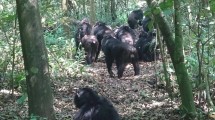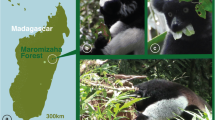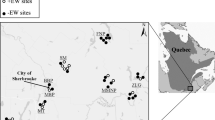Abstract
Geophagy among orangutans is the most poorly documented in contrast to the knowledge of soil-eating practices of other great ape species. Observations of soil consumption by orangutans in the Sungai Wain Forest Preserve (Wanariset) of Borneo are presented, along with physico-mineral–chemical analyses of the ingested soil in an effort to understand what might stimulate the activity. The consumed soils are: light colored, not excessively weathered by normal standards, higher in the clay size fraction relative to controls, and are comprised of a mix of clay minerals without any specificity of 1:1, 2:1 and/or 2:1:1 (Si:Al) species. The geophagic soils contain chlorides below detection limits, effectively eliminating salt as a stimulus. Soil chemical and geochemical analyses confirm that orangutans prefer soils with pH levels near or above 4.0, while controls are consistently lower (pH = 3.5–4.0), a considerable difference in acidity for at least four out of six soils consumed. Geochemical analysis shows Al, Fe and K are high in the consumed vs control samples; higher Al follows from higher clay percentages in the consumed earth. Iron and K may play physiological roles, but Fe is mostly in the ferrous form (Fe+2) and may not be readily taken up by the animals. The preferential choice of consumed samples, with pH above 4.0 and higher clay contents, may promote a more beneficial intestinal environment.






Similar content being viewed by others
References
Abrahams, P. W., & Parsons, J. A. (1997). Geophagy in the tropics: An appraisal of three geophagical materials. Environmental Geochemistry and Health, 19, 19–22.
Aufreiter, S., Mahaney, W. C., Hancock, R. G. V., & Stambolic, A. (1997). Geochemistry and mineralogy of soils eaten by humans. International Journal of Food Sciences and Nutrition, 40, 447–460.
Aufreiter, S., Mahaney, W. C., Milner, M. W., Hancock, R. G. V., Huffman, M., Wink, M., et al. (2001). Mineralogical and chemical interactions of soils eaten by chimpanzees of the Mahale and Gombe Stream National Parks, Tanzania. Journal of Chemical Ecology, 27, 285–311.
Bower, C. A., & Wilcox, L. V. (1965). Soluble salts. In C. A. Black (Ed.), Methods of soil analysis, part 2 (pp. 933–951). Madison, WI: American Society Agronomy.
Caton, J. M., Hume, I. D., Hill, D. M., & Harper, P. (1999). Digesta retention in the Gastro-intestinal tract of the Orang Utan (Pongo pygmaeus). Primates, 40(4), 551–558.
Day, P. E. (1965). Particle fractionation and particle size analysis. In C. A. Black (Ed.), Methods of soil analysis (pp. 545–567). Madison, WI: American Society of Agronomy.
Diatloff, E., Roberts, M., Sanders, D., & Roberts, S. K. (2004). Characterization of anion channels in the plasma membrane of Arabidopsis epidermal root cells and the identification of a citrate-permeable channel induced by phosphate starvation. Plant Physiology,. doi:10.1104/pp.104.046995.
Dierenfeld, E. S. (1997). Orangutan nutrition. In C. Sodaro (Ed.), Orangutan SSP husbandry manual. Brookfield, IL: Orangutan SSP and Brookfield Zoo.
Fossey, D. (1983). Gorillas in the mist. Boston: Houghton Mifflin.
Goodall, J. (1986). The chimpanzee of Gombe. Patterns of behaviour. Cambridge, MA: The Belknap Press of Harvard University Press.
Hamilton, R. A., & Galdikas, B. M. F. (1994). A preliminary study of food selection by the orang-utan in relation to plant quality. Primates, 35(3), 255–263.
Hanahan, D., & Weinberg, R. A. (2000). The hallmarks of cancer. Cell, 100, 57–70.
Hancock, R. G. V. (1984). On the source of clay used for Cologne Roman pottery. Archaeometry, 26, 210–217.
Harrison, T. P., & Hancock, R. G. V. (2005). Geochemical analysis and sociocultural complexity: A case study from early Iron Age Megiddo (Israel). Archaeometry, 47, 705–722.
Ji, Y. J., & Cui, M. Z. (1988). Toxicological studies on safety of rare earths used in agriculture. Biomedical Environment Sciences, 1(3), 270–276.
Ke, (1999). Geophagy in the golden-faced saki monkey (Pithecia pithecia chrysocephala) in the Central Amazon. Journal Zoological Society London, 277, 91–103.
Kempf, E. (2009). Patterns of water use in primates. Folia Primatologica, 80, 275–294.
Ketch, L. A., Malloch, D., Mahaney, W. C., & Huffman, M. (2001). Comparative microbial analysis and clay mineralogy of soils eaten by chimpanzees (Pan troglodytes schweinfurthii) in Tanzania. Soil Biology and Biochemistry, 33, 199–203.
Klein, N., Fruhlich, F., & Krief, S. (2008). Geophagy: Soil consumption enhances the bioactivities of plants eaten by chimpanzees. Naturwissenschaften, 95, 325–331.
Knott, C. D. (1998). Changes in orangutan caloric intake, energy balance and ketones in response to fluctuating fruit availability. International Journal of Primatology, 19, 1061–1079.
Kreulen, D. A. (1985). Lick use by large herbivores: A review of benefits and banes of soil consumption. Mammal Review, 15, 107–123.
Krishnamani, R., & Mahaney, W. C. (2000). Geophagy among primates; adaptive significance and ecological consequences. Animal Behaviour, 59, 899–915.
Mahaney, W. C. (1990). Ice on the Equator. Ellison Bay, WI: W.M Caxton Ltd.
Mahaney, W. C. (1993). Scanning electron microscopy of earth mined and eaten by mountain gorillas in the Virunga Mountains, Rwanda. Primates, 34(3), 311–319.
Mahaney, W. C. (2002). Atlas of sand grain surface textures and applications. Oxford: Oxford University Press.
Mahaney, W. C., Aufreiter, S., & Hancock, R. G. V. (1995a). Mountain gorilla geophagy: A possible seasonal behavior for dealing with the effects of dietary changes. International Journal of Primatology, 16(3), 475–488.
Mahaney, W. C., Hancock, R. G. V., Aufreiter, S., & Huffman, M. A. (1996). Geochemistry and clay mineralogy of termite mound soil and the role of geophagy in chimpanzees of the Mahale Mountains, Tanzania. Primates, 37(2), 121–134.
Mahaney, W. C., & Krishnamani, R. (2003). Understanding geophagy in animals: Standard procedures of sampling soils. Journal of Chemical Ecology, 29, 1477–1499.
Mahaney, W. C., Milner, M. W., Aufreiter, S., Hancock, R. G. V., Wrangham, R., & Campbell, S. (2005). Geophagy soils consumed by chimpanzees of the Kanyawara community in the Kibale Forest, Uganda. International Journal of Primatology, 26, 1375–1397.
Mahaney, W. C., Milner, M. W., Mulyono, H., Hancock, R. G. V., Aufreiter, S., Reich, M., & Wink, M. (2000). Mineral and chemical analyses of soils eaten by humans in Indonesia. International Journal of Environmental Health Research, 10, 93–109.
Mahaney, W. C., Milner, M. W., Sanmugadas, K., Hancock, R. G. V., Aufreiter, S., Wrangham, R., & Pier, H. W. (1997). Geophagy amongst chimpanzees in Kibale forest, Uganda, [Analysis of geophagy soils in Kibale Forest, Uganda]. Primates, 38(2), 159–176.
Mahaney, W. C., Stambolic, A., Knezevich, M., Hancock, R. G. V., Aufreiter, S., Sanmugadas, K., et al. (1995b). Geophagy amongst rhesus macaques on Cayo Santiago, Puerto Rico. Primates, 36(3), 323–333.
Mahaney, W. C., Watts, D. P., & Hancock, R. G. V. (1990). Geophagia by mountain gorillas (Gorilla gorilla beringei) in the Virunga Mountains, Rwanda. Primates, 31(1), 113–120.
Mahaney, W. C., Zippin, J., Milner, M. W., Sanmugadas, K., Hancock, R. G. V., Aufreiter, S., et al. (1999). Chemistry, mineralogy and microbiology of termite mound soil eaten by chimpanzees of the Mahale Mountains, Western Tanzania. Journal of Tropical Ecology, 15, 565–588.
Matsubayashi, H., Lagan, P., Majalap, N., Tanagah, J., Sukor, J. R. A., & Kitayama, K. (2006). Importance of natural licks for the mammals in Bornean inland tropical rain forests. Ecological Research,. doi:10.1007/s11284-006-0313-4.
Oates, J. F. (1978). Water-plant and soil consumption by guereza monkeys (Colobus guereza): A relationship with minerals and toxins in the diet? Biotropica, 10, 241–253.
Oyama, M., & Takehara, H. (1970). Standard soil color charts. Forestry and Fisheries: Japan Research Council for Agriculture.
Palizban, A. A., Sadeghi-Aliabadi, H., & Abdollahpour, F. (2010). Effect of cerium lanthanide on Hela and MCF-7 cancer cell growth in the presence of transferring. Research in Pharmaceutical Sciences, 5(2), 119–125.
Plumptre, A. J., Reynolds, V. & Bakuneeta, C. (1994). The contribution of fruit eating primates to seed dispersal and natural regeneration after selective logging. ODA project R 4738 report.
Pontzer, H., Raichen, D. A., Shumacher, R. W., Ocobock, C., & Wich, S. A. (2010). Metabolic adaptation for low energy throughput in orangutans. Proceedings of the National Academy of Sciences of the United States of America, 107(32), 14048–14052.
Reynolds, V., Plumptre., A. J., Greenham, J., & Harborne, J. (1998). Condensed tanning and sugars in the diet of chimpanzees (Pan troglodytes schweinfurthii) in the Budongo Forest, Uganda. Oecologia, 115, 331–336.
Russon, A. E. (2002). Return of the native: Cognition and site-specific expertise in orangutan rehabilitation. International Journal of Primatology, 23(3), 461–478.
Russon, A. E. & Susilo, A. (1999). The effects of the 1997–98 droughts and fires on orangutans in Sungai Wain Protection Forest, E. Kalimantan, Indonesia. In: H. Suhartoyo & T. Toma (Eds.), Impacts of fire and human activities on forest ecosystems in the tropics: Proceedings of the third international symposium on Asian tropical forest management (pp. 348–372). Samarinda, Indonesia: Tropical Forest Research Center, Mulawarman University and Japan International Cooperation Agency.
Russon, A. E., et al. (2009). Geographic variation in orangutan diet. In S. Wich, S. Utami Atmoko, T. Mitra Setia, & C. van Schaik (Eds.), Orangutans: Geographic variation in behavioral ecology and conservation. Oxford: Oxford University Press.
Schmidt, D. A., Kerley, M. S., Dampsey, J. L., Porton, I. J., Porter, J. H., Griffin, M. E., et al. (2005). Fiber digestibility by the Orangutan (Pongo abelii): In vitro and in vivo. Journal of Zoo and Wildlife Medicine, 36(4), 571–580.
Setz, E. Z. F., Enzweiler, J., Solferini, V. N., Amendola, M. P., & Berton, R. S. (1999). Geophagy in the golden-faced saki monkey (Pithecia pithecia chrysocephala) in the Central Amazon. Journal Zoological Society London, 277, 91–103.
Stambolic-Robb, A. (1997). Geophagy amongst free-ranging Orangutans (Pongo pygmaeus abelii) of Gunung Leuser National Park and rehabilitated Borneo Orangutans (Pongo pygmaeus pygmaeus) of Sungai Wain Forest, Indonesia. MSc. Thesis, York University, pp. 117.
Turra, C., Fernandes, E. A. N., & Bacchi, M. A. (2011). Evaluation on rare earth elements of Brazilian agricultural supplies. Journal of Environmental Chemistry and Ecotoxicology, 3(4), 86–92.
Tweheyo, M., & Obua, J. (2001). Feeding habits of chimpanzees (Pan troglodytes), red tailed monkeys (Cercopithecus ascanius schmidti) and blue monkeys (Cercopithecus mitis stuhlmanii) on figs in Budongo Forest Reserve, Uganda. African Journal of Ecology, 39, 1–7.
Voros, J., (2000). Geophagy by rehabilitated Orangutans (Pongo pygmaeus pygmaeus) in Sungai Wain Forest, Indonesian Borneo, MSc. Thesis, Dept. of Geography, York University, Toronto.
Voros, J., Mahaney, W. C., Krishnamani, R. K., Aufreiter, S., Hancock, R. G. V., & Milner, M. W. (2001). Geophagy by the Bonnet macaques (Macaca radiata) of Southern India: A preliminary analysis. Primates, 42, 327–344.
Wang, L., & Liang, T. (2014). Effects of exogenous rare earth elements on phosphorus adsorption and desorption in different types of soils. Chemosphere, 103, 148–155.
Wei, Z. L., Rui, Y. K. & Tian, Z. H. (2009). Content of rare earth elements in wild Hypericum japonicum Thunb. Published by NIH, US National Library of Medicine (on line only).
Whittig, L. D. (1965). X-ray diffraction techniques for numerical identification and mineralogical composition. In C. A. Black (Ed.), Methods of soil analysis (pp. 671–696). Madison WI: American Society Agronomy.
Wrangham, R. W., Conklin, N. L., Chapman, C. A., & Hunt, K. D. (1991). The significance of fibrous foods for Kibale forest chimpanzees. Philosophical Transactions of the Royal Society of London. Series B: Biological Science, 334(171), 178.
Yamazaki, S., Takeda, S., Torii, E., Suzuki, S., Shimizu, M., & Kurotori, H. (2010). Pedological analysis of geophagic behaviours in captive Borneo Orangutan (Pongo pygmaeus). Primate Research, 26(1), 59–66.
Zhang, H., Feng, J., Shu, W., Liu, C., Xu, S., Wu, D., et al. (2000). Chronic toxicity of rare-earth elements on human beings: Implications of blood biochemical indices in REE-high regions, South Jiangxi. Biological Trace Element Research, 73, 1–17.
Acknowledgments
This research was carried out with funding from Quaternary Surveys, Toronto and a minor research grant from York University to WCM. We thank Anne Russon (York University) for collecting the samples and making them available to us for analysis.
Author information
Authors and Affiliations
Corresponding author
Rights and permissions
About this article
Cite this article
Mahaney, W.C., Hancock, R.G.V., Aufreiter, S. et al. Bornean orangutan geophagy: analysis of ingested and control soils. Environ Geochem Health 38, 51–64 (2016). https://doi.org/10.1007/s10653-015-9678-z
Received:
Accepted:
Published:
Issue Date:
DOI: https://doi.org/10.1007/s10653-015-9678-z




